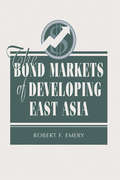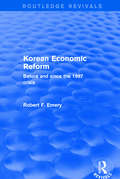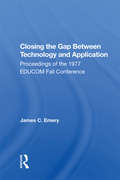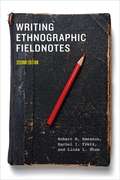- Table View
- List View
Navigating Time and Space in Population Studies (International Studies in Population #9)
by Emily R Merchant, Glenn D Deane, Myron P Gutmann and Kenneth M SylvesterNavigating Time and Space in Population Studies presents innovative approaches to long-standing questions about the diffusion of population and demographic behavior across space and over time. This collection utilizes newly-available historical data along with spatially and temporally explicit analytical methods to evaluate and refine core demographic theories and to pose new questions about mortality and fertility transitions, migration, urbanization, and social inequality. It adds a spatial dimension to the analysis of temporal processes and a temporal element to spatial processes. Chapters cover a broad range of geographical settings, including the United States, Europe, Latin America, and the Islamic world, and span time periods from the eighteenth to twentieth century. Contributors from a variety of disciplines reveal the complexity of factors involved in population processes that spread across space and unfold over time, and demonstrate a rich set of tools with which to explore, analyze, and test the spatial and temporal dynamics of these phenomena. The theories, methods, and substantive findings presented here provide new lenses through which to view time and space in population studies, offering useful models and valuable insights to demographers and other social scientists exploring both historical and contemporary questions about population dynamics anywhere in the world.
An American Icon in Puerto Rico: Barbie, Girlhood, and Colonialism at Play (Transnational Girlhoods #4)
by Emily R. Aguiló-PérezSince her creation in 1959, Barbie has become an icon of femininity to girls all over the world. In this study, author Emily R. Aguiló-Pérez focuses on a group of multigenerational Puerto Rican women and girls, exploring how playing with Barbie dolls as children has impacted their lives. By documenting the often-complicated relationships girls have with Barbie dolls, Aguiló-Pérez highlights the ways through which women and girls construct their own identities in relation to femininity, body image, race, and nationalism through Barbie play.
An American Icon in Puerto Rico: Barbie, Girlhood, and Colonialism at Play (Transnational Girlhoods #4)
by Emily R. Aguiló-PérezSince her creation in 1959, Barbie has become an icon of femininity to girls all over the world. In this study, author Emily R. Aguiló-Pérez focuses on a group of multigenerational Puerto Rican women and girls, exploring how playing with Barbie dolls as children has impacted their lives. By documenting the often-complicated relationships girls have with Barbie dolls, Aguiló-Pérez highlights the ways through which women and girls construct their own identities in relation to femininity, body image, race, and nationalism through Barbie play.
An American Icon in Puerto Rico: Barbie, Girlhood, and Colonialism at Play (Transnational Girlhoods #4)
by Emily R. Aguiló-PérezSince her creation in 1959, Barbie has become an icon of femininity to girls all over the world. In this study, author Emily R. Aguiló-Pérez focuses on a group of multigenerational Puerto Rican women and girls, exploring how playing with Barbie dolls as children has impacted their lives. By documenting the often-complicated relationships girls have with Barbie dolls, Aguiló-Pérez highlights the ways through which women and girls construct their own identities in relation to femininity, body image, race, and nationalism through Barbie play.
Other Worlds, Other Bodies: Embodied Epistemologies and Ethnographies of Healing
by Emily Pierini, Alberto Groisman, and Diana Espírito SantoWhen approaching the multiplicity of the spiritual experiences of healing, ethnographers are often presented with ideas of the existence of “other” worlds that may intersect with the so-called “material” or “physical” worlds. This book proposes a sensory ethnography of healing with a focus on ethnographic knowing as embedded in an embodied epistemology of healing. Epistemological embodiment signals that personal scholarly experience of the “unknown”—be it in the form of trance, or as the embodiment of an “other”—shapes the concepts of healing, body, trance, self, and matter by which ethnographers craft out analysis.
Rereading Empathy
by Emily Johansen and Alissa G. KarlOver the last few decades and from across a spectrum of centrist political thought, a variety of academic disciplines, and numerous public intellectuals, the claim has been that we need to empathize more with marginalized people as a way to alleviate social inequalities. If we all had more skill with empathy, so the claim goes, we would all be better citizens. But what does it mean to empathize with others? How do we develop this skill? And what does it offer that older models of solidarity don't? Why empathy-and why now?Rereading Empathy takes up these questions, examining the uses to which calls for empathy are put in the face of ever expanding economic and social precarity. The contributors draw on a variety of historical and contemporary literary and cultural archives to illustrate the work that empathy is supposed to enable-and to query alternative models of building collective futures.
Human-Environment Relations: Transformative Values in Theory and Practice
by Emily Brady and Pauline PhemisterThis fresh and innovative approach to human-environmental relations will revolutionise our understanding of the boundaries between ourselves and the environment we inhabit. The anthology is predicated on the notion that values shift back and forth between humans and the world around them in an ethical communicative zone called ‘value-space’. The contributors examine the transformative interplay between external environments and human values, and identify concrete ways in which these norms, residing in and derived from self and society, are projected onto the environment.
Migration and Social Work: Approaches, Visions and Challenges (Research in Social Work)
by Emilio José Gómez-Ciriano, Elena Cabiati and Sofia DedotsiWith cross-cultural perspectives from contributors in nine countries, this book showcases much-needed research on current issues around migration and social work in Europe. Focusing on the reception, experiences and integration of refugees and asylum seekers, the chapters also consider the impact of recent EU policies on borders and integration. With racism on the rise in some European societies, the book foregrounds international social work values as a common framework to face discriminatory practice at macro and micro levels. Featuring recommendations for inclusive practice that ‘opens doors’, this book features the voices of migrants and the practitioners aiding their inclusion in new societies.
Thirty-two New Takes on Taiwan Cinema
by Emilie Yueh-yu Yeh Darrell William Davis Wenchi LinThirty-two New Takes on Taiwan Cinema covers thirty-two films from Taiwan, addressing a flowering of new talent, moving from art film to genre pictures, and nonfiction. Beyond the conventional framework of privileging “New and Post-New Cinema,” or prominence of auteurs or single films, this volume is a comprehensive, judicious take on Taiwan cinema that fills gaps in the literature, offers a renewed historiography, and introduces new creative force and voices of Taiwan’s moving image culture to produce a leading and accessible work on Taiwan film and culture. Film-by-film is conceived as the main carrier of moving picture imagery for a majority of viewers, across the world. The curation offers an array of formal, historical, genre, sexual, social, and political frames, which provide a rich brew of contexts. This surfeit of meanings is carried by individual films, one by one, which breaks down abstractions into narrative bites and outsized emotions.
Performing Cultures of Equality (GRACE Project)
by Emilia María Durán-AlmarzaThis book examines the enactment of gendered in/equalities across diverse Cultural forms, turning to the insights produced through the specific modes of onto-epistemological enquiry of embodied performance. It builds on work from the GRACE (Gender and Cultures of Equality in Europe) project and offers both theoretical and methodological analyses of an array of activities and artworks. The performative manifestations discussed include theatre, installations, social movements, mega-events, documentaries, and literary texts from multiple geopolitical locales. Engaging with the key concepts of re-enactment and relationality, the contributions explore the ways in which in/equalities are relationally re-produced in and through individual and collective bodies. This multi- and trans-disciplinary collection of essays creates fruitful dialogues within and beyond Performance Studies, sitting at the crossroads of ethnography, event studies, social movements, visual studies, critical discourse analysis, and contemporary approaches to textualities emerging from post-colonial and feminist studies.
How Everyday Forms of Racial Categorization Survived Imperialist Censuses in Puerto Rico
by Rebecca Jean Emigh Patricia Ahmed Dylan RileyThis book examines the history of racial classifications in Puerto Rico censuses, starting with the Spanish censuses and continuing through the US ones. Because Puerto Rican censuses were collected regularly over hundreds of years, they are fascinating “test cases” to see what census categories might have been available and effective in shaping everyday ones. Published twentieth-century censuses have been well studied, but this book also examines unpublished documents in previous centuries to understand the historical precursors of contemporary ones. State-centered theories hypothesize that censuses, especially colonial ones, have powerful transformative effects. In contrast, this book shows that such transformations are affected by the power and interests of social actors, not the strength of the state. Thus, despite hundreds of years of exposure to the official dichotomous and trichotomous census categories, these categories never replaced the continuous everyday ones because the census categories rarely coincided with Puerto Rican’s interests.
Performing Masculinity
by R. Emig A. RowlandThis interdisciplinary study analyzes the ways in which signs of masculinity have been performed across a wide variety of contexts and genres - including literature, classical ballet, sports, rock music, films and computer games - from the early nineteenth century to the present day.
The Bond Markets Of Developing East Asia
by Robert F EmeryThis comprehensive book provides detailed descriptions and analysis of the bond markets in eight East Asian developing economies: Hong Kong, Indonesia, South Korea, Malaysia, the Philippines, Singapore, Taiwan, and Thailand. Drawing on the most recent data available, Emery assesses the strengths and weaknesses of each countrys bond market, concluding with comparisons of the eight countries bond markets. The book will be an invaluable reference for economists, policymakers, and all those interested in emerging capital markets. }Drawing on the most recent data available, this comprehensive book provides detailed descriptions and analysis of the bond markets in eight East Asian developing economies: Hong Kong, Indonesia, South Korea, Malaysia, the Philippines, Singapore, Taiwan, and Thailand. Robert Emery devotes a full chapter to evaluating the strengths and weaknesses of each countrys bond market. For each country, Emery describes the history of the bond market and identifies its key participants, the different types of bonds, and the current terms for bond issues. He also discusses the size of the bond market, the bond issuing process, trading procedures and the structure of the market, the clearing and settlement system, and fees and taxes. Finally, he lists the regulators of the market, current regulations, and bond rating agencies; assesses the markets past performance; and offers suggestions for improvement.Each country chapter is organized into a standard format, making it easy for the reader to locate and compare specific information. Emery concludes the book with cross-country comparisons of the eight countries bond markets. It will be an invaluable reference for economists, policymakers, and all those interested in emerging capital markets. }
Korean Economic Reform: Before and Since the 1997 Crisis (Routledge Revivals Ser.)
by Robert F. EmeryThis title was first published in 2001. In 1997 the author was told, by an official at the Korean embassy in Washington DC, that the most serious economic problem facing Korea was the need for reform of the financial sector. This proved to be true, as a financial crisis hit Korea in November 1997. Though problems arising before November 1997 indicate that Korea's economic problems were not solely financial. This study covers earlier reform efforts, the 1997 crisis and the measures taken by Korea since then to deal with the country's economic problems. It attempts to analyze the problems and offer suggestions as to how problems might corrected or resolved.
Korean Economic Reform: Before and Since the 1997 Crisis (Routledge Revivals Ser.)
by Robert F. EmeryThis title was first published in 2001. In 1997 the author was told, by an official at the Korean embassy in Washington DC, that the most serious economic problem facing Korea was the need for reform of the financial sector. This proved to be true, as a financial crisis hit Korea in November 1997. Though problems arising before November 1997 indicate that Korea's economic problems were not solely financial. This study covers earlier reform efforts, the 1997 crisis and the measures taken by Korea since then to deal with the country's economic problems. It attempts to analyze the problems and offer suggestions as to how problems might corrected or resolved.
A History of the Paper Pattern Industry: The Home Dressmaking Fashion Revolution
by Joy Spanabel EmerySewing patterns have been the principle blueprint for making garments in the home for centuries. From their origins in the tailoring manuals of the 16th century to the widely produced pamphlets of the 18th and 19th centuries, through to the full size packet patterns of today, their history and development has reflected major changes in technology (such as the advent of the sewing machine), retailing and marketing practices (the fashion periodical), and shifts in social and cultural influences.This accessible book explores this history, outlining innovations in patternmaking by the companies who produced patterns and how these reflected the fashions and demands of the market.Showcasing beautiful illustrations from original pattern pamphlets, packets and ads, as well as 9 complete patterns from which readers can reproduce vintage garments of different eras, the book provides a unique visual guide to homemade fashions as well as essential exploration of the industry that produced them.
A History of the Paper Pattern Industry: The Home Dressmaking Fashion Revolution
by Joy Spanabel EmerySewing patterns have been the principle blueprint for making garments in the home for centuries. From their origins in the tailoring manuals of the 16th century to the widely produced pamphlets of the 18th and 19th centuries, through to the full size packet patterns of today, their history and development has reflected major changes in technology (such as the advent of the sewing machine), retailing and marketing practices (the fashion periodical), and shifts in social and cultural influences.This accessible book explores this history, outlining innovations in patternmaking by the companies who produced patterns and how these reflected the fashions and demands of the market.Showcasing beautiful illustrations from original pattern pamphlets, packets and ads, as well as 9 complete patterns from which readers can reproduce vintage garments of different eras, the book provides a unique visual guide to homemade fashions as well as essential exploration of the industry that produced them.
Closing The Gap Between Technology And Application
by James C. EmeryThis book presents analyses, from three points of view, of the use of computing technology in higher education. It considers application areas including office automation, distributed academic computing, distributed administrative computing, instructional systems, and information resources.
Closing The Gap Between Technology And Application
by James C. EmeryThis book presents analyses, from three points of view, of the use of computing technology in higher education. It considers application areas including office automation, distributed academic computing, distributed administrative computing, instructional systems, and information resources.
Reframing Japonisme: Women and the Asian Art Market in Nineteenth-Century France, 1853–1914 (Contextualizing Art Markets)
by Elizabeth EmeryJaponisme, the nineteenth-century fascination for Japanese art, has generated an enormous body of scholarship over the last twenty years, but most of it neglects women, who also acquired objects from the Far East and displayed them in their homes before selling or bequeathing them to museums. The stories of women collectors and shopkeepers rarely appear in memoirs left by those associated with the japoniste movement.The present volume thus brings to light the culturally important, yet largely forgotten artistic activities of women such as Clémence d'Ennery (1823-1898), who began collecting Japanese and Chinese chimeras in the 1840s, built a house for them in the 1870s, and bequeathed the 'Musée d'Ennery' to the state as a free public museum in 1893. A friend of the Goncourt brothers and a fifty-year patron of Parisian dealers of Asian art, d'Ennery's struggles to gain recognition as a collector and curator serve as a lens through which to examine the japonisme of other women of her day, from dealers of Japanese art (Madame Desoye, Florine Langweil), salon hostesses (Princesse Mathilde, Louise Cahen d'Anvers), and writers and actresses (Judith Gautier, Sarah Bernhardt), to travellers (Isabella Stewart Gardner, Louisine Havemeyer), and artists (Mary Cassatt, Marie Nordlinger).Largely absent from the history of japonisme, these women-and many others-actively collected Japanese art, interacted with auction houses and art dealers, and formed collections now at the heart of museums such as the Louvre, the Musée Guimet, the Musée Cernuschi, the Musée Unterlinden, and the Metropolitan Museum of Art.
Reframing Japonisme: Women and the Asian Art Market in Nineteenth-Century France, 1853–1914 (Contextualizing Art Markets)
by Elizabeth EmeryJaponisme, the nineteenth-century fascination for Japanese art, has generated an enormous body of scholarship over the last twenty years, but most of it neglects women, who also acquired objects from the Far East and displayed them in their homes before selling or bequeathing them to museums. The stories of women collectors and shopkeepers rarely appear in memoirs left by those associated with the japoniste movement.The present volume thus brings to light the culturally important, yet largely forgotten artistic activities of women such as Clémence d'Ennery (1823-1898), who began collecting Japanese and Chinese chimeras in the 1840s, built a house for them in the 1870s, and bequeathed the 'Musée d'Ennery' to the state as a free public museum in 1893. A friend of the Goncourt brothers and a fifty-year patron of Parisian dealers of Asian art, d'Ennery's struggles to gain recognition as a collector and curator serve as a lens through which to examine the japonisme of other women of her day, from dealers of Japanese art (Madame Desoye, Florine Langweil), salon hostesses (Princesse Mathilde, Louise Cahen d'Anvers), and writers and actresses (Judith Gautier, Sarah Bernhardt), to travellers (Isabella Stewart Gardner, Louisine Havemeyer), and artists (Mary Cassatt, Marie Nordlinger).Largely absent from the history of japonisme, these women-and many others-actively collected Japanese art, interacted with auction houses and art dealers, and formed collections now at the heart of museums such as the Louvre, the Musée Guimet, the Musée Cernuschi, the Musée Unterlinden, and the Metropolitan Museum of Art.
Writing Ethnographic Fieldnotes, Second Edition (Chicago Guides to Writing, Editing, and Publishing)
by Robert M. Emerson Rachel I. Fretz Linda L. ShawIn Writing Ethnographic Fieldnotes, Robert M. Emerson, Rachel I. Fretz, and Linda L. Shaw present a series of guidelines, suggestions, and practical advice for creating useful fieldnotes in a variety of settings, demystifying a process that is often assumed to be intuitive and impossible to teach. Using actual unfinished notes as examples, the authors illustrate options for composing, reviewing, and working fieldnotes into finished texts. They discuss different organizational and descriptive strategies and show how transforming direct observations into vivid descriptions results not simply from good memory but from learning to envision scenes as written. A good ethnographer, they demonstrate, must learn to remember dialogue and movement like an actor, to see colors and shapes like a painter, and to sense moods and rhythms like a poet. This new edition reflects the extensive feedback the authors have received from students and instructors since the first edition was published in 1995. As a result, they have updated the race, class, and gender section, created new sections on coding programs and revising first drafts, and provided new examples of working notes. An essential tool for budding social scientists, the second edition of Writing Ethnographic Fieldnotes will be invaluable for a new generation of researchers entering the field.
Writing Ethnographic Fieldnotes, Second Edition (Chicago Guides to Writing, Editing, and Publishing)
by Robert M. Emerson Rachel I. Fretz Linda L. ShawIn Writing Ethnographic Fieldnotes, Robert M. Emerson, Rachel I. Fretz, and Linda L. Shaw present a series of guidelines, suggestions, and practical advice for creating useful fieldnotes in a variety of settings, demystifying a process that is often assumed to be intuitive and impossible to teach. Using actual unfinished notes as examples, the authors illustrate options for composing, reviewing, and working fieldnotes into finished texts. They discuss different organizational and descriptive strategies and show how transforming direct observations into vivid descriptions results not simply from good memory but from learning to envision scenes as written. A good ethnographer, they demonstrate, must learn to remember dialogue and movement like an actor, to see colors and shapes like a painter, and to sense moods and rhythms like a poet. This new edition reflects the extensive feedback the authors have received from students and instructors since the first edition was published in 1995. As a result, they have updated the race, class, and gender section, created new sections on coding programs and revising first drafts, and provided new examples of working notes. An essential tool for budding social scientists, the second edition of Writing Ethnographic Fieldnotes will be invaluable for a new generation of researchers entering the field.
Writing Ethnographic Fieldnotes, Second Edition (Chicago Guides to Writing, Editing, and Publishing)
by Robert M. Emerson Rachel I. Fretz Linda L. ShawIn Writing Ethnographic Fieldnotes, Robert M. Emerson, Rachel I. Fretz, and Linda L. Shaw present a series of guidelines, suggestions, and practical advice for creating useful fieldnotes in a variety of settings, demystifying a process that is often assumed to be intuitive and impossible to teach. Using actual unfinished notes as examples, the authors illustrate options for composing, reviewing, and working fieldnotes into finished texts. They discuss different organizational and descriptive strategies and show how transforming direct observations into vivid descriptions results not simply from good memory but from learning to envision scenes as written. A good ethnographer, they demonstrate, must learn to remember dialogue and movement like an actor, to see colors and shapes like a painter, and to sense moods and rhythms like a poet. This new edition reflects the extensive feedback the authors have received from students and instructors since the first edition was published in 1995. As a result, they have updated the race, class, and gender section, created new sections on coding programs and revising first drafts, and provided new examples of working notes. An essential tool for budding social scientists, the second edition of Writing Ethnographic Fieldnotes will be invaluable for a new generation of researchers entering the field.
Writing Ethnographic Fieldnotes, Second Edition (Chicago Guides to Writing, Editing, and Publishing)
by Robert M. Emerson Rachel I. Fretz Linda L. ShawIn Writing Ethnographic Fieldnotes, Robert M. Emerson, Rachel I. Fretz, and Linda L. Shaw present a series of guidelines, suggestions, and practical advice for creating useful fieldnotes in a variety of settings, demystifying a process that is often assumed to be intuitive and impossible to teach. Using actual unfinished notes as examples, the authors illustrate options for composing, reviewing, and working fieldnotes into finished texts. They discuss different organizational and descriptive strategies and show how transforming direct observations into vivid descriptions results not simply from good memory but from learning to envision scenes as written. A good ethnographer, they demonstrate, must learn to remember dialogue and movement like an actor, to see colors and shapes like a painter, and to sense moods and rhythms like a poet. This new edition reflects the extensive feedback the authors have received from students and instructors since the first edition was published in 1995. As a result, they have updated the race, class, and gender section, created new sections on coding programs and revising first drafts, and provided new examples of working notes. An essential tool for budding social scientists, the second edition of Writing Ethnographic Fieldnotes will be invaluable for a new generation of researchers entering the field.















